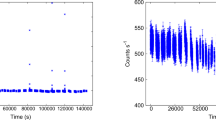Abstract
The circumstellar plasma that produces Hα emission in Algol binaries has been investigated using phase-resolved, high dispersion data acquired from CCD and image tube detectors. Results are summarized in this paper, including discussions of the disk geometry and size, asymmetry in the distribution of material, long-term or non-phase dependent variability, mass outflow, the mean electron density, and how the latter properties vary with the system's period or location in the r-q diagram. Five systems which display permanent emission with periods ranging from 4.5 to 261 days (SW Cyg, UX Mon, TT Hya, AD Her, and RZ Oph) are intercompared. If P < 4.5 days, no permanent disks are observed, while if P > 6 days, stable disks with only slight long-term variations in their Hα brightness are seen. The most variable systems appear to be those in the 5 – 6 day range, but the star's position in the r-q diagram has the largest influence on its behavior. The trailing side of the accretion disk, where the gas stream impacts the inner disk, is usually brighter, and the leading side is often times more extended. The disk extends out to at least 95% of the Roche surface of the primary and is highly flattened (≤RP). Mass outflow near phase 0.5 is commonplace.
Similar content being viewed by others
References
Batten, A. H., and Fletcher, J. M. 1978, Publ. A.S.P., 90, 312.
Etzel, P. B. 1988, A.J., 95, 1204.
Hall, D. S., and Garrison, L. M. Jr. 1972, Publ. A.S.P., 84, 552.
Joy, A. H. 1942, Publ. A.S.P., 54, 35.
Kaitchuck, R. H., and Honeycutt, R. K. 1982, Ap.J., 258, 224.
Knee, L. B. G., Scarfe, C. D., Mayor, M., Baldwin, B. W., and Meatheringham, S. J. 1086, Astr. Ap., 168, 72.
Lubow, S. H., and Shu, F. H. 1975, Ap.J., 198, 383.
Peters, G. J. 1980, in Close Binary Stars: Observations and Interpretations (IAU Symposium No. 88), ed. M. J. Plavec, D. M. Popper, and R. K. Ulrich (Dordrecht: Reidel), p. 287.
Plavec, M. J. 1988, A.J., 96, 755.
Struve, O. 1948, Publ. A. S. P., 60, 160.
Struve, O. 1949, M.N.R.A.S., 109, 487.
Wyse, A. B. 1934, Lick Obs. Bull., No. 17, 42.
Author information
Authors and Affiliations
Rights and permissions
About this article
Cite this article
Peters, G.J. The Hα emitting regions of the accretion disks in Algols. Space Sci Rev 50, 9–22 (1989). https://doi.org/10.1007/BF00215915
Received:
Accepted:
Issue Date:
DOI: https://doi.org/10.1007/BF00215915




